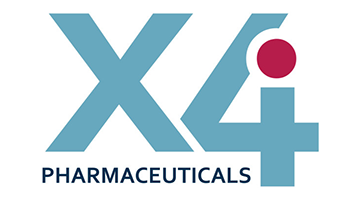X4 Pharmaceuticals Presents New Clinical Data at ASH 2021 Further Supporting Potential of Mavorixafor + Ibrutinib to Treat Patients with Double-Mutation Waldenström’s Macroglobulinemia
Current TAP Partner

BOSTON, Dec. 11, 2021 (GLOBE NEWSWIRE) -- X4 Pharmaceuticals, Inc. (Nasdaq: XFOR), a leader in the discovery and development of novel CXCR4-targeted small molecule therapeutics to benefit people with immune system dysfunction, today announced new positive efficacy and safety data from the ongoing Phase 1b clinical trial of its lead candidate mavorixafor, in combination with ibrutinib, for patients with Waldenström’s macroglobulinemia (WM) and confirmed MYD88 and CXCR4 mutations. These study results were reported today in a poster presentation at the American Society of Hematology (ASH) Annual Meeting, taking place both virtually and in person in Atlanta, GA, December 11-14, 2021.
What’s New in This Poster?
- As of October 12, 2021, 16 patients were enrolled in the Phase 1b clinical trial, with 14 being evaluable as of the data cut, all at low- (200 mg) and mid-level (400 mg) dosing of mavorixafor; median duration of treatment was 272.5 days (range 33-435 days); 12 patients remain on study.
For all patients on study (both frontline and refractory):
- The median level of serum IgM reduced from 47.2 g/L (N=14) at baseline to 7.73 g/L (N=3) after 12 months of treatment.
- In 10 patients evaluable for response, the overall response rate was 100% (ORR = >25% reduction in serum IgM), with four achieving a Major Response (>50% reduction in serum IgM), including one Very Good Partial Response (VGPR) of >90% reduction in serum IgM.
- The median level of hemoglobin approached normal, increasing by approximately 38 g/L from baseline (N=14) to month 12 (N=3).
- Overall, the combination of mavorixafor and ibrutinib was tolerated with a manageable safety profile at the low- and mid-level dosing of mavorixafor; dose escalation to 600 mg mavorixafor is ongoing.
For patients with refractory disease:
- Median decreases in serum IgM from 50.2 g/L at baseline (N=8) to 7.7 g/L at 12 months (N=3) were similar to decreases seen in a previous study of ibrutinib monotherapy in Waldenström’s patients without CXCR4 mutations.
- An ORR of 100% (N=7), with two achieving a Major Response, including one VGPR, was seen.
- Median time-on-treatment for patients achieving a Major Response was 51.7 weeks (N=3); median time on treatment for patients achieving Minor Responses (MR = 25% to <50% reduction in serum IgM) was 30.1 weeks (N=4).
- The median level of hemoglobin approached normal, increasing by approximately 32 g/L from baseline (N=18) to month 12 (N=1).